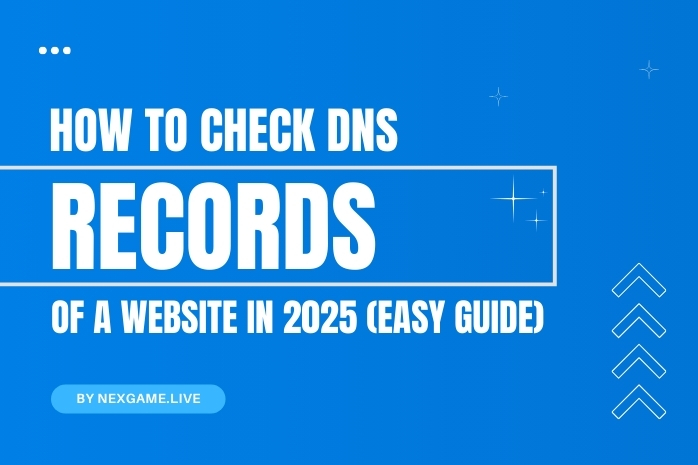How to Check DNS Records of a Website in 2025 Published: 06 May, 2025

When it comes to understanding how websites function, DNS (Domain Name System) records are a crucial part of the puzzle. Whether you're managing your own website, troubleshooting issues, or analyzing a competitor's setup, learning how to check DNS records can be incredibly valuable.
In this guide, we’ll walk you through everything you need to know about DNS records in 2025 — including what they are, how they work, and how you can easily view them using NexGame and other reliable tools.
What Are DNS Records and Why Are They Important?
DNS records are like the phone book of the internet. They map domain names to their respective IP addresses and provide important instructions for email, web traffic, and more.
When someone enters a URL like example.com in their browser, DNS records tell the browser where to send the request — helping it reach the correct server.
Some common DNS record types include:
-
A Record: Points the domain to an IPv4 address.
-
AAAA Record: Points the domain to an IPv6 address.
-
MX Record: Directs emails to the right mail server.
-
CNAME Record: Points one domain to another (used for subdomains).
-
NS Record: Specifies the name servers responsible for the domain.
-
TXT Record: Contains text data for verification (like SPF, DKIM).
Without proper DNS configuration, your website might not load, or emails could fail to deliver — making DNS records essential for online reliability.
How to Check DNS Records Using NexGame
NexGame offers a simple, free DNS Lookup tool that gives you quick access to detailed DNS information for any domain. Here’s how to use it:
-
Visit NexGame's DNS Lookup Tool
Go to https://nexgame.live/dns-lookup -
Enter the Domain Name
Type the website you want to check (e.g.,example.com) into the search box. -
Click "Lookup"
Within seconds, you’ll see a detailed list of DNS records — A, MX, NS, CNAME, TXT, and more.
NexGame simplifies the process so even beginners can easily understand DNS setups without needing technical expertise.
What Can You Learn from DNS Records?
DNS records can reveal a lot about a website’s structure and setup:
-
Server IP Address: Know where the site is hosted.
-
Email Provider: Identify which service (like Google Workspace or Zoho) is handling emails.
-
CDN or Proxy Services: See if the domain is protected by services like Cloudflare.
-
Subdomains: Spot related services or alternate platforms.
-
SPF, DKIM, DMARC: Understand if the domain has email authentication in place.
This information is helpful for developers, marketers, cybersecurity analysts, and business owners.
Other DNS Lookup Tools You Can Use
While NexGame is our top recommendation, here are some alternatives:
-
Google Admin Toolbox
Great for detailed analysis with a clean interface. -
MXToolbox
Offers advanced monitoring features and diagnostics. -
DNSChecker.org
Useful for checking DNS propagation across global locations.
That said, for quick and reliable checks with an easy interface, NexGame remains one of the best free tools available in 2025.
Common DNS Record Issues You Can Identify
DNS records also help you troubleshoot common problems:
-
Website not loading? Check the A or CNAME record.
-
Emails bouncing? Investigate your MX and TXT records.
-
Subdomain not working? Look into CNAME or A records for the subdomain.
-
SSL not validating? Make sure CAA or TXT verification is in place.
By spotting issues early, you can prevent downtime, improve performance, and protect your online presence.
Best Practices for Managing DNS Records
Even if you’re not a developer, it’s good to understand these best practices:
-
Always double-check entries before updating.
-
Avoid deleting existing records unless you’re sure of their purpose.
-
Set low TTLs (Time to Live) temporarily when testing changes.
-
Regularly monitor changes using NexGame or DNS history tools.
-
Work with your hosting provider or domain registrar for secure updates.
Conclusion
DNS records might seem technical, but understanding them can empower you to troubleshoot issues, optimize your website, and make smarter digital decisions. Tools like NexGame make it easier than ever to check and analyze DNS records in seconds.
Whether you're a site owner or just curious about how the web works, knowing how to read and understand DNS records gives you a powerful edge in the digital world of 2025.
FAQs
1. What is a DNS record?
A DNS record is an entry in a DNS database that maps a domain name to various pieces of information, like IP addresses or mail servers.
2. Why would I check DNS records?
Checking DNS records helps troubleshoot issues, verify domain setups, and gather technical data about websites.
3. How do I check DNS records for free?
You can use NexGame’s DNS Lookup tool to check records instantly without signing up.
4. What is the difference between A and CNAME records?
An A record maps a domain to an IP address, while a CNAME record maps one domain name to another.
5. Can DNS records affect email delivery?
Yes. Incorrect MX, SPF, DKIM, or DMARC records can cause email delivery failures or increase the risk of spam.